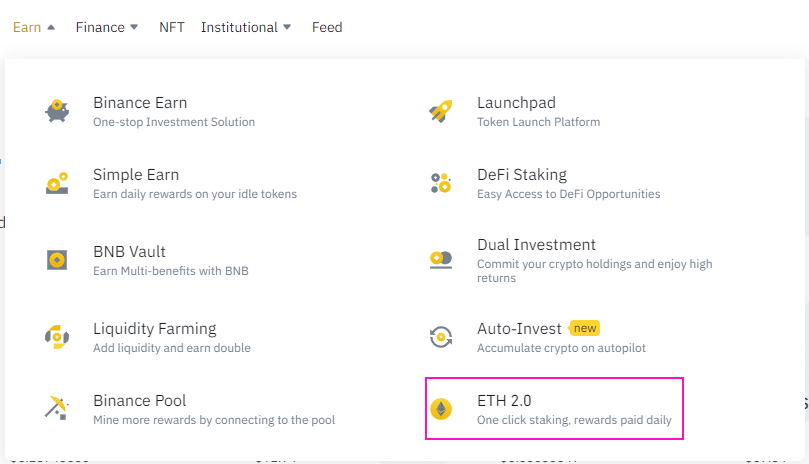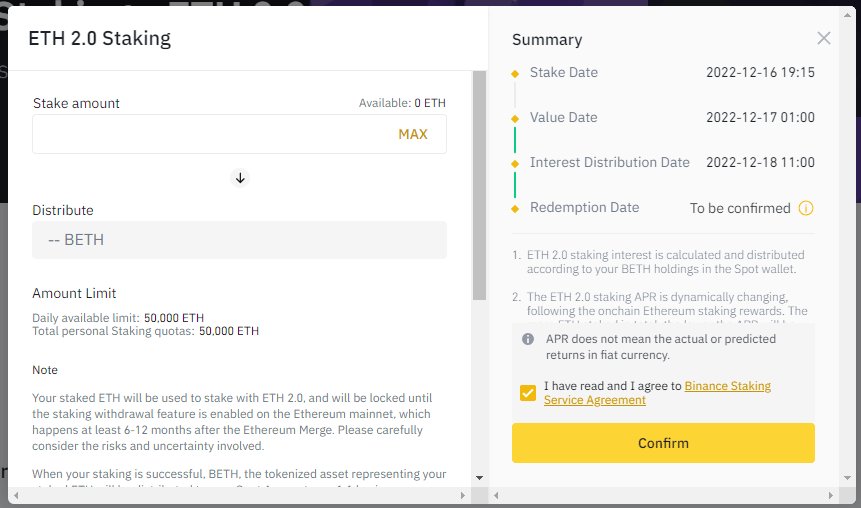ETH 2.0 Staking on Binance — Earn Staking Rewards on Your Ethereum Holdings

In September 2022, the Ethereum blockchain platform entered a new era thanks to The Merge, which brought the network over to Proof-of-Stake consensus. This new phase of the Ethereum project is often called Ethereum 2.0.
In addition to the new consensus algorithm, which has already been successfully implemented on the mainnet, Ethereum 2.0 will also bring key upgrades such as sharding. If everything goes according to plan, Ethereum’s scalability will receive a major boost, allowing the platform to process a much larger number of transactions while keeping costs low.
While ETH can now be staked and the Ethereum runs on Proof-of-Stake, there are a couple of problems with ETH staking that users need to be aware of.
The two main problems with ETH staking and how you can avoid them
First off, ETH that is currently staked is essentially locked and cannot be withdrawn. This will only become possible after the Ethereum blockchain receives the Shanghai upgrade—the current estimate for when the upgrade will be ready is March 2023, althought it’s not set in stone.
The second issue with Ethereum staking is that it’s not easy to stake ETH by yourself. This is because you need to have 32 ETH if you want to launch a validator. Even though the Ethereum price has dropped significantly in the bear market, 32 ETH is still too large of an investment for many people.
Thankfully, there exist solutions that address these very problems. One such example is the ETH 2.0 staking service offered by Binance, which is the world’s most popular cryptocurrency exchange. On Binance you can stake your ETH and earn rewards while retaining liquidity, and you can also stake smaller quantities of ETH.
Let’s check out Binance’s ETH 2.0 staking service and how it can help you earn some extra rewards on top of your ETH holdings.
Stake ETH on Binance and Earn Rewards
What is ETH 2.0 staking on Binance?
Binance gives you the ability to stake your ETH coins and earn staking rewards even if you don’t have 32 ETH or don’t want to run your own validator. Binance pools together ETH from multiple users and uses it to launch validators. This is why you can stake your ETH through Binance even if you don’t have 32 ETH. The minimum amount of ETH you can stake is just 0.0001, so the service is truly accessible to everyone.
Another unique aspect of Binance ETH 2.0 staking is that Binance covers slashing risks. Slashing is a mechanism implemented by Ethereum that punishes validators that aren’t following the rules by removing part of their ETH stake.
The pros of ETH 2.0 staking on Binance:
- You can stake as little 0.0001 ETH
- You don’t have to worry about operating your own validators
- You can access liquidity even though your ETH is staked
- Binance covers slashing risks
- Arguably the most convenient ETH staking option available today
The cons of ETH 2.0 staking on Binance:
- Not suitable for users who prefer to self-custody their coins
- Users don’t have control over the behavior of Binance’s validators
Binance’s ETH 2.0 staking offering centers around BETH, a token issued by Binance that represents staked ETH. Before we show you how to stake ETH on Binance, it’s very important that you understand BETH so that you’re aware of the benefits and risks.
What is BETH?
BETH is a token issued by Binance that allows users to preserve their liquidity even after staking their ETH. After you stake ETH with Binance, you will receive an equivalent amount of BETH. You will receive staking rewards periodically based on the amount of BETH you hold on Binance. Note that you will only accumulate staking rewards on BETH tokens held in your Binance Spot Wallet.
BETH tokens can be traded on the open market—for example, if your ETH is staked but you need funds right now, you can simply sell some of your BETH.
Once the withdrawal of staked ETH becomes possible on the Ethereum blockchain, Binance will give users the option to redeem BETH for ETH on a 1:1 basis. If you don’t want to wait until then, you can trade your BETH on the open market, but please be aware that BETH usually has a price of less than 1 ETH.
The reason why the market values BETH less than ETH is that BETH has some inherent risks that ETH doesn’t have. For example, it might take a long time for staked ETH withdrawals to be enabled on Ethereum.
Another risk of BETH is that you have to trust Binance that they will be redeeming BETH for ETH on a 1:1 basis. While we don’t have a good reason to believe Binance wouldn’t honor this commitment, the fact is that nothing is 100% certain—there’s always a degree of risk that something goes wrong.
At the time of writing, 1 BETH can be purchased on Binance for about 0.954 ETH. If you have a lot of confidence that 1 BETH will be redeemable for 1 ETH, this is an interesting opportunity to grow your ETH holdings.
How to stake ETH on Binance?
The process of staking ETH on Binance is simple – it only takes a few clicks. If you don’t have a Binance account yet, you’ll have to create one first. With a Binance account, you’ll also have access to a whole suite of services for crypto investors beyond just ETH 2.0 staking. Please keep in mind that you will need to verify your identity if you want to use Binance’s services (including ETH 2.0 staking)
Create Binance Account
Once your account is ready to go, head over to the main page of Binance and select the “Earn” section in the navigation bar. Then, choose “ETH 2.0”.

Select “Stake Now”.

The next step is to select the amount of ETH that you wish to stake. The amount can’t exceed the amount of ETH you have deposited on Binance.

In the summary, you will see four different dates. Here’s what they mean:
- Stake Date: The time and date at which you staked your ETH
- Value Date: The time and date at which your staked ETH will become eligible for accumulating rewards
- Interest distribution date: The time and date at which you’ll receive your first staking rewards
- Redemption date: The date at which it will become possible to redeem BETH for ETH on a 1:1 basis. This date is currently unknown, as the Ethereum mainnet hasn’t yet received the Shanghai upgrade.
Before you proceed, make sure to go through the Binance Staking Service Agreement so that you understand the risks associated with the product.
That’s all there is to it. You will receive BETH tokens equal to the amount of ETH you staked. Then, you will start earning rewards on the BETH tokens in your spot wallet. The rewards accrue on a daily basis.
The bottom line — ETH 2.0 staking on Binance is the most convenient way to earn Ethereum staking rewards
If you’re looking for a simple way of participating in Ethereum staking, it’s hard to beat the ETH 2.0 staking service from Binance. It addresses the two main problems with ETH staking, namely the temporary loss of liquidity and the high barrier to entry. By staking your ETH on Binance, you can keep most of your ETH’s liquidity and you can also stake smaller amounts.
You can stake your ETH on Binance in just a few clicks, and the exchange even covers slashing risks. While everyone can benefit from ETH 2.0 staking on Binance, the service is especially useful for newer entrants into the crypto space, as well as users that have a relatively small crypto portfolio.






 Bitcoin
Bitcoin  Ethereum
Ethereum  Tether
Tether  USDC
USDC  TRON
TRON  Dogecoin
Dogecoin  Cardano
Cardano  Bitcoin Cash
Bitcoin Cash  Chainlink
Chainlink  LEO Token
LEO Token  Stellar
Stellar  Litecoin
Litecoin  Hedera
Hedera  Monero
Monero  Dai
Dai  OKB
OKB  Cronos
Cronos  Ethereum Classic
Ethereum Classic  Gate
Gate  Cosmos Hub
Cosmos Hub  VeChain
VeChain  Algorand
Algorand  KuCoin
KuCoin  Stacks
Stacks  Tether Gold
Tether Gold  Theta Network
Theta Network  Zcash
Zcash  IOTA
IOTA  Tezos
Tezos  TrueUSD
TrueUSD  NEO
NEO  Polygon
Polygon  Decred
Decred  Dash
Dash  Ravencoin
Ravencoin  Zilliqa
Zilliqa  Qtum
Qtum  Synthetix Network
Synthetix Network  Basic Attention
Basic Attention  0x Protocol
0x Protocol  Siacoin
Siacoin  Holo
Holo  DigiByte
DigiByte  Enjin Coin
Enjin Coin  Nano
Nano  Status
Status  Ontology
Ontology  Waves
Waves  Hive
Hive  Lisk
Lisk  Pax Dollar
Pax Dollar  Steem
Steem  BUSD
BUSD  Numeraire
Numeraire  NEM
NEM  Huobi
Huobi  OMG Network
OMG Network  Bitcoin Gold
Bitcoin Gold  Ren
Ren  Augur
Augur  HUSD
HUSD